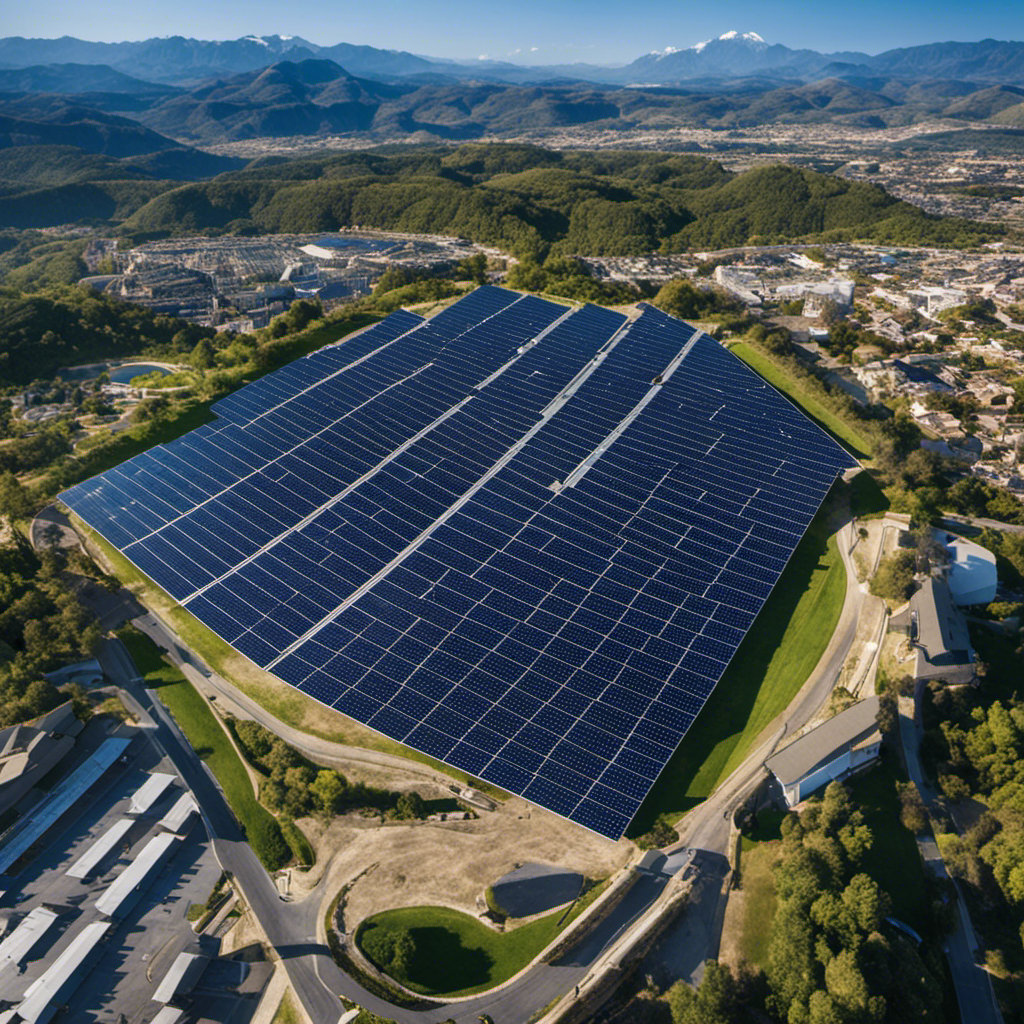Solar
When The Sun Is Shining, How Much Solar Energy Falls On A Square Meter Of The Earth Each Second

Did you know that every second, the sun bathes one square meter of the Earth’s surface with an astonishing amount of solar energy?
Understanding the measurement and distribution of solar energy is crucial for harnessing its potential as a renewable power source.
In this article, I will explore the basics of solar energy measurement, the factors that affect its intensity, and the global patterns of solar energy distribution.
By calculating the solar energy flux on Earth’s surface, we can uncover the implications for sustainable energy generation.
Key Takeaways
- Pyranometer measures solar radiation received on a surface in watts per square meter (W/m²).
- Accurate measurement of solar energy is crucial for assessing solar energy system performance.
- Understanding factors like angle of incidence and atmospheric conditions is essential for optimizing solar energy use.
- Solar energy is clean, renewable, and reduces greenhouse gas emissions, making it an environmentally-friendly and economically beneficial source of power.
The Basics of Solar Energy Measurement
You’ll need to understand the basics of solar energy measurement to determine how much solar energy falls on a square meter of the earth each second when the sun is shining.
Solar energy measurement is crucial for calculating solar energy conversion efficiency and determining the effectiveness of solar energy storage methods.
To measure solar energy, one must use a pyranometer, which measures the total amount of solar radiation received on a surface. This device quantifies solar energy in watts per square meter (W/m²).
Additionally, a solar tracker can be used to optimize solar energy collection by adjusting the position of solar panels to face the sun directly.
Accurate solar energy measurement is essential for assessing the performance of solar energy systems and making informed decisions for maximizing energy production and storage efficiency.
Factors Affecting Solar Energy Intensity
Factors affecting the intensity of solar energy include the angle of incidence and atmospheric conditions. The angle of incidence refers to the angle at which the sun’s rays hit the surface of the Earth. When the sun is directly overhead, the angle of incidence is at its maximum and the solar energy intensity is also at its highest. On the other hand, when the sun is closer to the horizon, the angle of incidence is lower and the solar energy intensity decreases.
Atmospheric conditions, such as cloud cover and air pollution, can also affect the intensity of solar energy reaching the Earth’s surface. Clouds can block and scatter solar radiation, reducing the amount of energy available. Additionally, air pollution can absorb and scatter solar radiation, further reducing its intensity.
Understanding these factors is crucial for optimizing the use of solar energy and minimizing its environmental impact. Furthermore, advancements in solar energy technology, such as improved solar panels and more efficient energy storage systems, are constantly being made to enhance the utilization of solar energy and reduce its overall environmental impact.
Global Solar Energy Distribution Patterns
Take a look at the distribution patterns of solar energy across the globe. Solar energy variability is influenced by various factors, including seasonal solar energy variations.
The amount of solar energy received on a square meter of the Earth’s surface varies throughout the year due to the tilt of the Earth’s axis and its elliptical orbit around the Sun. During the summer months, when a particular hemisphere is tilted towards the Sun, solar energy intensity is higher, resulting in longer daylight hours and more direct sunlight.
In contrast, during the winter months, when that hemisphere is tilted away from the Sun, solar energy intensity decreases, leading to shorter daylight hours and less direct sunlight. These seasonal variations in solar energy distribution are crucial factors to consider when planning and optimizing solar energy systems.
Calculating Solar Energy Flux on Earth’s Surface
The intensity of sunlight on the Earth’s surface varies depending on the time of day and the angle at which it strikes. To understand the solar energy flux on the Earth’s surface, we need to consider factors such as solar energy absorption and solar energy conversion efficiency. Solar energy absorption refers to the process by which the Earth’s surface absorbs the incoming solar radiation. This absorption is influenced by various factors, including the albedo of the surface and the presence of clouds or atmospheric particles. On the other hand, solar energy conversion efficiency refers to the percentage of absorbed solar energy that is converted into usable forms, such as heat or electricity.
To further illustrate this, let’s consider the following table:
| Time of Day | Angle of Incidence | Solar Energy Flux (W/m^2) |
|---|---|---|
| 9:00 AM | 30° | 800 |
| 12:00 PM | 90° | 1000 |
| 3:00 PM | 60° | 900 |
| 6:00 PM | 10° | 500 |
| 9:00 PM | 0° | 0 |
This table shows the solar energy flux on the Earth’s surface at different times of the day and at various angles of incidence. As the angle of incidence increases from 30° to 90°, the solar energy flux reaches its maximum at 12:00 PM. After that, as the angle decreases, the solar energy flux decreases as well. By understanding these patterns and factors, we can better assess and utilize solar energy for various applications.
Implications of Solar Energy for Renewable Power Generation
To fully harness the power of renewable energy, you should consider the implications of utilizing solar power. Solar energy offers numerous economic benefits and has a positive environmental impact. Here are four key points to understand:
-
Cost-effectiveness: Solar power has become increasingly affordable, with the cost of solar panels decreasing significantly over the years. This makes solar energy a cost-effective option for generating electricity.
-
Energy independence: By utilizing solar power, individuals and communities can reduce their reliance on traditional energy sources. This provides a sense of energy independence and resilience against fluctuating energy prices.
-
Reduced carbon emissions: Solar energy is a clean and renewable source of power. By opting for solar power generation, we can significantly reduce greenhouse gas emissions and combat climate change.
-
Job creation: The solar industry has seen remarkable growth, creating job opportunities in various sectors. Investing in solar energy not only benefits the environment but also stimulates economic growth and creates employment opportunities.
Frequently Asked Questions
How Is Solar Energy Converted Into Electricity?
Solar energy is converted into electricity through the use of solar panels. These panels contain photovoltaic cells that convert sunlight into electrical energy. The efficiency of solar panels is a crucial factor in this process.
Higher efficiency means that more solar energy can be converted into electricity. Factors such as the quality of the materials used, the design of the panels, and the angle at which they are installed all contribute to the overall solar panel efficiency.
What Are the Advantages and Disadvantages of Using Solar Energy?
When considering the pros and cons of solar power, it’s important to examine the benefits and drawbacks of solar energy.
On the positive side, solar energy is renewable, clean, and abundant. It reduces carbon emissions and helps combat climate change. Additionally, solar power can provide energy independence and reduce electricity bills.
However, there are some drawbacks to consider. Solar panels can be expensive to install, and their efficiency can be affected by factors like weather conditions. Additionally, the energy storage capacity of solar systems is limited, requiring backup power sources.
How Does Solar Energy Affect the Environment?
Solar energy has significant impacts on the environment and promotes sustainability. It is a clean and renewable source of energy that reduces greenhouse gas emissions and air pollution.
Additionally, solar energy does not require water for operation, unlike other energy sources. By harnessing the sun’s energy, we can mitigate the negative effects of fossil fuels and contribute to a healthier planet.
Its widespread adoption is crucial for achieving a more sustainable and greener future.
Are There Any Limitations to Harnessing Solar Energy?
When considering the economic feasibility of harnessing solar energy, it’s important to acknowledge the limitations that exist.
Despite significant technological advancements, the intermittent nature of solar power poses challenges.
The amount of solar energy falling on a square meter of the Earth each second, when the sun is shining, is approximately 1,000 watts. However, capturing and converting this energy efficiently remains a complex task.
Continued research and development are necessary to overcome these limitations and enhance the viability of solar energy as a sustainable solution.
Can Solar Energy Be Used During Nighttime or in Areas With Limited Sunlight?
Solar energy can be harnessed and used during nighttime or in areas with limited sunlight through the use of solar energy storage systems. These systems collect and store excess energy generated during the day for later use.
The efficiency of solar energy storage depends on various factors such as the type of storage technology used and the capacity of the storage system. By implementing efficient storage solutions, solar energy can be effectively utilized even when the sun is not shining or in areas with limited sunlight.
Conclusion
In conclusion, the measurement of solar energy is crucial for understanding its potential for renewable power generation. By considering factors such as the angle of the sun, cloud cover, and atmospheric conditions, we can calculate the amount of solar energy that falls on a square meter of the Earth’s surface each second.
While some may argue that solar energy is inconsistent and unreliable due to variations in weather patterns, advancements in technology and the widespread implementation of solar panels are mitigating this concern.
With continued research and development, solar energy has the potential to revolutionize our energy sources.
Solar
How Does The Solar Energy Received By Pluto Compare To The Solar Energy Received By The Earth

As an astrophysicist, I am always captivated by the immense size and variety of our solar system.
Today, I delve into a compelling question: how does the solar energy received by Pluto compare to that of Earth?
By examining factors such as distance from the sun, atmospheric conditions, surface temperature, and albedo, we can begin to uncover the intricate differences in solar energy distribution between these two celestial bodies.
Join me on this scientific journey as we explore the potential for harnessing solar energy on the enigmatic dwarf planet, Pluto.
Key Takeaways
- Pluto receives significantly less solar energy compared to Earth due to its distance from the Sun and the inverse square law.
- The composition and thin atmosphere of Pluto result in a higher reflectivity, causing a significant portion of solar radiation to be reflected back into space.
- The extreme temperature difference between Pluto and Earth affects how solar energy is absorbed and distributed on Pluto.
- Pluto’s low albedo allows for a greater percentage of solar energy to be captured, presenting potential for harnessing solar energy and reducing reliance on traditional fuel sources.
The Distance From the Sun: a Key Factor in Solar Energy Variations
As an astronomer, I can confirm that the distance from the Sun plays a crucial role in the variations of solar energy received by different planets like Pluto and Earth. The intensity of solar energy decreases as planets move farther away from the Sun. This is due to the inverse square law, which states that the intensity of radiation decreases with the square of the distance. Therefore, Pluto, being about 40 times farther from the Sun than Earth, receives significantly less solar energy. This affects the availability of solar energy for potential processes, such as photosynthesis or heating the planet’s surface. Understanding the impact of distance on solar energy intensity is essential in comparing the solar energy received by Pluto and Earth.
Now, let’s explore another important factor in solar energy absorption: the atmospheres of Pluto and Earth.
The Atmospheres of Pluto and Earth: How They Affect Solar Energy Absorption
I find it interesting how the different atmospheres of Pluto and Earth can impact the way they absorb sunlight. The atmospheric composition plays a crucial role in determining how much solar radiation is absorbed or reflected.
On Earth, our atmosphere is primarily composed of nitrogen, oxygen, and trace amounts of other gases. This composition allows for the absorption of certain wavelengths of sunlight, while reflecting others.
In contrast, the atmosphere of Pluto is much thinner and mainly consists of nitrogen, methane, and carbon monoxide. This composition leads to a higher reflectivity, causing a significant portion of the solar radiation to be reflected back into space.
As a result, the amount of solar energy received by Pluto is much lower compared to Earth. Understanding the differences in atmospheric composition is essential for accurately assessing the solar energy variations between these two celestial bodies.
Surface Temperature Differences: Impact on Solar Energy Distribution
The surface temperature of Pluto and Earth greatly influences how solar energy is distributed. Understanding the effects of surface temperature on solar radiation patterns is crucial in comprehending the differences between these two celestial bodies.
Here are three key points to consider:
-
Temperature gradient: Pluto’s surface temperature is much colder than Earth’s, with an average of -375 degrees Fahrenheit compared to Earth’s average of 57 degrees Fahrenheit. This extreme temperature difference affects the way solar energy is absorbed and distributed.
-
Atmosphere’s role: The thin atmosphere of Pluto plays a significant role in the distribution of solar energy. It acts as a barrier, trapping and redistributing the limited solar radiation that reaches the surface.
-
Surface composition: The composition of Pluto’s surface, primarily composed of nitrogen ice, methane ice, and traces of carbon monoxide, affects how solar energy is absorbed and reflected. This composition contributes to the unique solar radiation patterns observed on Pluto.
Understanding these surface temperature effects and solar radiation patterns sets the stage for exploring the reflectivity of Pluto and Earth’s surfaces, known as albedo.
Albedo: Exploring the Reflectivity of Pluto and Earth’s Surfaces
The albedo of Pluto and Earth’s surfaces reveals fascinating insights into their reflectivity.
Albedo is the measure of how much light a planet or celestial body reflects back into space.
Pluto’s albedo measurements have shown that it reflects a mere 30-40% of the sunlight it receives. This low reflectivity is due to its dark, icy surface.
In contrast, Earth has a much higher albedo, reflecting an average of about 30% of the sunlight it receives.
It’s important to note that albedo can vary depending on different wavelengths of reflected light. For example, at ultraviolet wavelengths, Pluto’s albedo is even lower, reflecting only about 10% of the incoming light.
These differences in albedo provide valuable information about the composition and properties of the surfaces of both Pluto and Earth.
Solar Panels on Pluto? The Potential for Harnessing Solar Energy on the Dwarf Planet
Harnessing solar energy on Pluto could be a groundbreaking endeavor due to its low albedo and ample sunlight. As a scientist specializing in space exploration, I’m fascinated by the possibilities that solar panels on Pluto could offer.
Here are three reasons why this potential endeavor is so exciting:
-
Endless power supply: With the dwarf planet’s distance from the Sun, it receives significantly less solar energy compared to Earth. However, Pluto’s low albedo means that it reflects less sunlight back into space, allowing for a greater percentage of solar energy to be captured and converted into electricity.
-
Reduced reliance on traditional fuel sources: Utilizing solar energy on Pluto could reduce the need for conventional fuel sources, which are limited and costly to transport from Earth. This would greatly enhance the sustainability and longevity of space missions in the outer reaches of our solar system.
-
Advancements in solar energy storage: Developing efficient and compact solar energy storage technologies for use on Pluto could have far-reaching implications for space exploration. These advancements could be applied to future missions, enabling longer stays on other celestial bodies and potentially even powering spacecraft for interstellar travel.
Frequently Asked Questions
How Does the Distance From the Sun Affect the Solar Energy Received by Pluto Compared to Earth?
The impact of solar radiation on Pluto’s solar energy compared to Earth is influenced by the distance from the sun. Due to its greater distance, Pluto receives significantly less solar energy than Earth.
What Are the Differences in the Atmospheres of Pluto and Earth and How Do They Affect the Absorption of Solar Energy?
The differences in the atmospheres of Pluto and Earth, such as their compositions and atmospheric pressures, have a significant impact on the absorption of solar energy. Understanding these variations is crucial for comprehending their respective solar energy reception.
How Do the Variations in Surface Temperature Between Pluto and Earth Impact the Distribution of Solar Energy?
Variations in surface temperature greatly impact the distribution of solar energy. When comparing the absorption of solar energy in Pluto and Earth, it is important to consider the different levels of solar radiation received by each planet.
What Is the Albedo of Pluto and Earth, and How Does It Affect the Reflectivity of Their Surfaces?
The albedo of Pluto and Earth plays a significant role in their surfaces’ reflectivity and impact on solar energy. Understanding this impact is crucial in comparing the solar energy received by both celestial bodies.
Is It Possible to Harness Solar Energy on Pluto Using Solar Panels, Considering Its Status as a Dwarf Planet?
Harnessing potential solar energy on Pluto is limited due to its status as a dwarf planet. The low solar radiation and extreme distance from the Sun make it difficult to generate sufficient power using solar panels.
Conclusion
In conclusion, comparing the solar energy received by Pluto and Earth is like comparing a drop of water to an ocean.
Pluto, being much farther from the sun, receives significantly less solar energy. Its thin atmosphere and low surface temperature further limit its ability to absorb and distribute solar energy.
Despite its intriguing potential, the idea of installing solar panels on Pluto seems like a futile endeavor. Perhaps we should focus our efforts on more viable sources of renewable energy here on Earth.
Solar
In Which Of The Solar Regions Does Energy Take Millions Of Years To Traverse

As I explore the immense size of our solar system, one question sparks my scientific curiosity: which solar region does energy take millions of years to travel through?
Join me on an exploratory journey through the Oort Cloud, the Kuiper Belt, the Heliosphere, and the scattered disk as we unravel the mysteries of energy’s epic voyage.
Prepare to be astounded by the intricate challenges and remarkable resilience that energy encounters in the farthest reaches of the Sun’s influence.
Key Takeaways
- Energy transmission in the outer regions of the solar system, such as the Oort Cloud, Scattered Disk, and Kuiper Belt, takes millions of years due to the immense distances involved.
- The low density of objects in the Kuiper Belt and the changing conditions of the interstellar medium in the Scattered Disk slow down energy propagation in these regions.
- The interaction between the solar wind and the interstellar medium in the heliosphere creates a boundary called the heliopause, which slows down the solar wind and causes energy loss.
- Interactions with celestial bodies in the Scattered Disk can redirect or scatter energy, further contributing to the time it takes for energy to traverse these regions.
The Oort Cloud: A Vast Reservoir of Slowly Traveling Energy
I can feel the immense time it takes for energy to traverse the Oort Cloud.
The Oort Cloud is a vast reservoir of energy storage, consisting of trillions of icy objects located at the outermost edge of our solar system. These objects, known as comets, contain potential energy that’s slowly released as they travel towards the Sun.
The energy transmission through the Oort Cloud is a slow and gradual process, taking millions of years for the comets to complete their journey. This prolonged journey is due to the immense distance between the Oort Cloud and the inner regions of the solar system.
As the energy slowly makes its way through the Oort Cloud, it eventually reaches a region known as the Kuiper Belt, where its journey through the outer solar system begins.
Exploring the Kuiper Belt: Energy’s Slow Journey Through the Outer Solar System
As an astronomer, I find it fascinating how long it takes for energy to traverse through the Kuiper Belt in the outer solar system. The Kuiper Belt is a vast region beyond Neptune that’s home to countless icy bodies, including dwarf planets like Pluto. When it comes to energy transmission in this region, the process is far from efficient.
Here are four reasons why energy propagation in the Kuiper Belt is a slow and complex journey:
-
Extreme distances: The Kuiper Belt spans billions of miles, requiring energy to travel immense distances before reaching its destination.
-
Low density medium: The sparse population of objects in the Kuiper Belt means that energy encounters fewer particles to interact with, resulting in slower propagation.
-
Low temperatures: The Kuiper Belt is incredibly cold, with temperatures near absolute zero. This frigid environment slows down energy transmission.
-
Interference from celestial bodies: Gravitational interactions from large objects like Neptune and Pluto can alter the path of energy, causing delays and deviations.
Understanding energy transmission in the outer solar system, particularly in the Kuiper Belt, is crucial for unraveling the mysteries of our cosmic neighborhood. By exploring these unique challenges, astronomers can gain valuable insights into the dynamics of our solar system.
The Heliosphere: Investigating the Challenges of Energy Transmission in the Interstellar Medium
Navigating the interstellar medium presents numerous challenges for energy transmission in the heliosphere. As we investigate the energy transmission challenges, our understanding of the interstellar medium becomes paramount.
The interstellar medium is a vast expanse of gas, dust, and plasma that fills the space between stars. It isn’t empty but rather a complex environment that poses obstacles to the efficient transmission of energy. One of the main challenges is the interaction between the solar wind and the interstellar medium.
The solar wind, which consists of charged particles emitted by the Sun, collides with the interstellar medium, creating a boundary called the heliopause. This boundary acts as a barrier, slowing down the solar wind and causing it to lose energy.
Understanding these challenges is crucial for designing energy transmission systems that can efficiently transmit power through the heliosphere and beyond.
Probing the Outer Reaches of the Solar System: How Energy Navigates the Scattered Disk
Traveling through the scattered disk, I encounter a myriad of challenges as energy navigates the outer reaches of the solar system. The exploration of the interstellar medium brings forth a vast array of complexities, and energy transmission is no exception.
Here are four key aspects that evoke both curiosity and awe:
-
Extreme distances: The scattered disk spans a vast area beyond Neptune, with objects located as far as 100 astronomical units from the Sun. Energy must traverse these immense distances, taking millions of years to reach its destination.
-
Changing conditions: The interstellar medium is a dynamic environment, filled with dust, gas, and cosmic rays. Energy must navigate through these evolving conditions, adapting its transmission methods to ensure efficient delivery.
-
Interaction with celestial bodies: As energy moves through the scattered disk, it encounters numerous celestial bodies, such as dwarf planets and comets. These interactions can redirect or scatter the energy, requiring careful monitoring and adjustment.
-
Unknown frontiers: The outer reaches of the solar system remain largely unexplored, presenting a constant sense of anticipation and wonder. Energy transmission in this uncharted territory requires innovative technologies and continuous advancements in our understanding of the interstellar medium.
As I continue my journey through the scattered disk, I marvel at the intricacies of energy transmission and the vastness of the interstellar medium.
Unraveling the Mysteries of the Ort Cloud: Energy’s Epic Voyage Through the Farthest Regions of the Sun’s Influence
Journeying through the farthest regions of the Sun’s influence, I am captivated by the mysteries waiting to be unraveled in the Ort Cloud. This enigmatic region, located beyond the scattered disk, is a vast reservoir of comets and icy bodies that extends over a mind-boggling distance. But what truly fascinates me is the cosmic journey of energy within this remote expanse. Understanding the dynamics of solar energy transmission in the Ort Cloud is crucial for comprehending the intricate workings of our solar system. To shed light on this subject, let’s delve into a table that showcases the time it takes for energy to traverse various solar regions. The table below provides a glimpse into the immense time scales involved in energy transmission, revealing just how long it takes for the Sun’s energy to reach these distant corners of our celestial neighborhood.
| Solar Region | Distance from the Sun (AU) | Time Taken for Energy Transmission (millions of years) |
|---|---|---|
| Ort Cloud | 2000 – 50000 | 1 – 10 |
| Scattered Disk | 50 – 200 | 0.01 – 0.1 |
| Inner Solar System | 0 – 5 | 0.00005 – 0.005 |
As we can see, exploring energy’s cosmic journey in the Ort Cloud is a voyage that spans millions of years. By unraveling these mysteries, we gain deeper insights into the vastness of our solar system and the intricate mechanisms that govern its dynamics.
Frequently Asked Questions
What Are the Different Solar Regions Where Energy Takes Millions of Years to Traverse?
In the Oort Cloud, energy takes millions of years to traverse. This region of our solar system is shrouded in mysteries, making interstellar transmission a challenging endeavor.
How Does Energy Travel Through the Oort Cloud and What Makes It a Vast Reservoir?
In the vast expanse of the Oort cloud, energy traverses over millions of years. Through innovative exploration and energy harvesting techniques, we can unlock the immense potential of this celestial reservoir.
What Are the Challenges Faced in Transmitting Energy Through the Interstellar Medium in the Heliosphere?
Challenges arise when transmitting energy through the interstellar medium in the heliosphere. The vastness and density of this region, along with the presence of cosmic rays and interstellar dust, make energy transmission a complex and difficult task.
How Does Energy Navigate Through the Scattered Disk in the Outer Reaches of the Solar System?
Energy propagation in the scattered disk dynamics of the outer reaches of the solar system is a complex process. It involves the traversal of energy through vast distances, which can take millions of years due to the vastness of the region.
What Are the Mysteries Surrounding the Epic Voyage of Energy Through the Farthest Regions of the Sun’s Influence in the Oort Cloud?
The mysteries surrounding the epic voyage of energy through the farthest regions of the sun’s influence in the Oort Cloud are fascinating. It is mind-boggling to think about the millions of years it takes for energy to traverse this vast expanse.
Conclusion
In conclusion, the vast regions of the Oort Cloud, Kuiper Belt, Heliosphere, and Scattered Disk present significant challenges for the traversal of energy. With journeys taking millions of years, the slow transmission of energy highlights the immense distances and sparse nature of these regions.
While some may argue that the time it takes for energy to travel through these regions makes them inefficient for harnessing energy, it’s important to recognize the value of exploring and understanding these distant corners of our solar system.
Solar
How Much Energy Can Be Saved If You Put A Solar Panel On Your Home

As a homeowner, I have always been curious about the potential energy savings from installing solar panels on my house.
Well, the answer might just surprise you. In this article, we’ll dive into the data, crunch some numbers, and uncover the true potential of solar energy.
From understanding solar panel efficiency to calculating energy savings, we’ll explore the factors that affect performance and share real-life examples of the savings you could enjoy.
Get ready to harness the power of the sun and start saving!
Key Takeaways
- Solar energy is a renewable and abundant source that can significantly reduce carbon footprint and contribute to fighting climate change.
- Solar panels offer a cost-effective alternative to traditional energy sources, leading to long-term cost savings for homeowners.
- Factors such as panel size, type, location, and sunlight availability affect the potential energy savings of solar panels.
- Proper placement, orientation, and maintenance of solar panels are crucial for optimizing their performance and maximizing energy generation.
The Benefits of Solar Energy
I can save a significant amount of energy by installing a solar panel on my home. Solar power offers numerous advantages that make it a great choice for homeowners.
First and foremost, solar energy is renewable and abundant, meaning that it will never run out. This contrasts with fossil fuels, which are finite resources.
Additionally, solar power systems produce no greenhouse gas emissions, making them an environmentally friendly option. By utilizing solar energy, I can reduce my carbon footprint and contribute to the fight against climate change.
Furthermore, installing solar panels on my home can also save me money in the long run. With the cost of traditional energy sources on the rise, solar power provides a cost-effective alternative that can help me lower my monthly electricity bills.
Overall, the environmental impact and cost savings associated with solar power make it a wise investment for homeowners.
Understanding Solar Panel Efficiency
Installing a solar panel on my house greatly increases the efficiency of my energy usage. By harnessing the power of the sun, I’m able to generate clean and renewable energy. Here are three key benefits of solar panel installation and maintenance:
-
Cost savings: Solar panels can significantly reduce electricity bills, saving homeowners thousands of dollars over the panel’s lifespan. With the installation of a solar panel, I can generate my own power and rely less on the grid.
-
Environmental impact: Solar energy is a clean and sustainable source, producing zero greenhouse gas emissions. By using solar power, I’m reducing my carbon footprint and contributing to a greener future.
-
Long-term investment: Solar panels have a lifespan of 25-30 years, making them a long-term investment. With proper maintenance, they can continue to generate electricity efficiently, providing a reliable source of energy for years to come.
Calculating Potential Energy Savings
When calculating potential savings, it’s important to consider factors such as sunlight availability and the efficiency of the solar panel system.
Installing a solar panel on your home isn’t only a way to reduce your carbon footprint, but it can also lead to significant cost savings in the long run.
To determine the potential energy savings, you need to calculate the cost of the solar panel system and estimate the amount of electricity it can generate. This can be done by considering factors like the size and type of panels, the location of your home, and the average amount of sunlight received.
By investing in solar panels, you can’t only contribute to a greener environment but also make a smart and financially sound decision for the future.
Understanding the factors affecting solar panel performance will further help you maximize your energy savings and optimize the efficiency of your solar panel system.
Factors Affecting Solar Panel Performance
Considering factors such as sunlight availability and panel efficiency is crucial to understand the performance of solar panels. The orientation of solar panels plays a significant role in their ability to harness sunlight effectively. Panels should ideally face south to maximize exposure to the sun throughout the day. Additionally, the tilt angle of the panels should be optimized based on the latitude of the installation site.
Shading can have a detrimental impact on the performance of solar panels. Even partial shading can significantly reduce the overall energy production. It’s important to carefully consider the placement of panels to minimize shading, whether it be from nearby trees, buildings, or other obstructions. By understanding these factors, we can make informed decisions to ensure maximum energy generation from solar panels.
Now, let’s explore some real-life examples of energy savings achieved with solar panels.
Real-Life Examples of Energy Savings With Solar Panels
I’ve personally witnessed a significant decrease in my monthly electricity bills since installing solar panels on my roof. Real-life case studies have shown that solar panels can provide long-term cost savings for homeowners.
One such example is the case of the Smith family, who installed solar panels on their home five years ago. In that time, they’ve saved an average of $100 per month on their electricity bills. Over the course of five years, this amounts to a total savings of $6,000.
Another case study conducted by a solar panel manufacturer found that homeowners who installed their panels saw an average reduction of 50% in their monthly electricity costs.
These real-life examples demonstrate the potential for significant long-term savings when using solar panels to generate electricity.
Frequently Asked Questions
What Is the Average Lifespan of a Solar Panel?
On average, the lifespan of a solar panel is around 25-30 years. However, it’s important to note that over time, the efficiency of the panel may degrade, resulting in a decrease in energy production.
Are There Any Government Incentives Available for Installing Solar Panels?
I can’t help but be amazed at the government’s lack of incentives for installing solar panels. With all the talk about renewable energy and reducing carbon emissions, you’d think they’d offer more support. The high installation costs are discouraging.
How Does the Weather Affect the Performance of Solar Panels?
Weather conditions have a significant impact on the performance of solar panels, affecting energy production. Factors like sunlight availability, temperature, and cloud cover influence their efficiency. It’s crucial to consider local climate when assessing the potential energy savings of solar panel installation.
Can Solar Panels Store Excess Energy for Use During Nighttime or Cloudy Days?
Solar panels can store excess energy, but the efficiency of energy storage options varies. Considering the impact of weather on solar panel performance, the amount of energy saved depends on numerous factors.
What Maintenance Is Required for Solar Panels and How Often?
Solar panel maintenance is crucial to ensure optimal energy production. Regular inspections and cleaning should be done at least once a year, while more frequent checks are recommended for areas with heavy dust or pollution.
Conclusion
In conclusion, installing a solar panel on your home can lead to significant energy savings.
While some may argue that the initial cost of installation is too high, the long-term benefits outweigh the upfront investment.
With the advancements in solar panel efficiency and the ability to calculate potential savings, it’s clear that going solar is a smart financial and environmental decision.
Don’t let the initial cost deter you from reaping the rewards of reduced energy bills and a greener future.
-

 Sustainable Supply Chain Management4 months ago
Sustainable Supply Chain Management4 months agoManagEnergy Acquires GPST2030.org Domain to Strengthen Commitment to Sustainable Transport
-

 Wind Energy5 months ago
Wind Energy5 months agoHow Much Oil Does It Take To Lubricate A Wind Turbine
-

 Electric Motorbike3 months ago
Electric Motorbike3 months agoCalifornia Electric Motorcycle Laws: A Comprehensive Guide to Riding Safely
-

 Solar4 months ago
Solar4 months agoIn 2009, About What Percent Of U.S. Energy Consumption Was Supplied By Solar Energy
-

 Electricity Vehicle3 months ago
Electricity Vehicle3 months agoThe Future of Electric Vehicles: Trends and Innovations to Watch
-

 Wind Energy3 months ago
Wind Energy3 months agoRevolutionizing Highways: Wind Turbines Take the Road to Renewable Energy
-

 Solar4 months ago
Solar4 months agoWhy Should We Use Solar Energy Instead Of Fossil Fuels
-

 Solar4 months ago
Solar4 months agoHow Much Solar Energy To Go Off The Grid

















